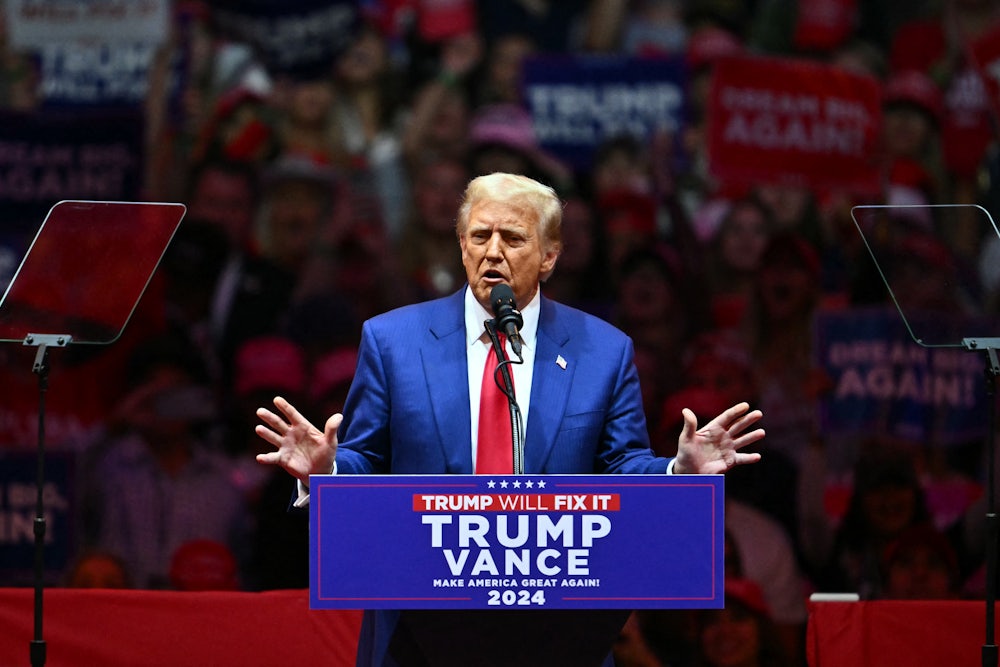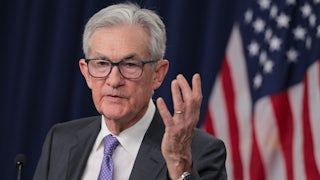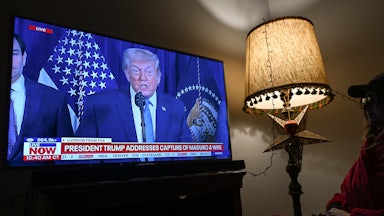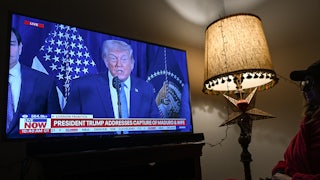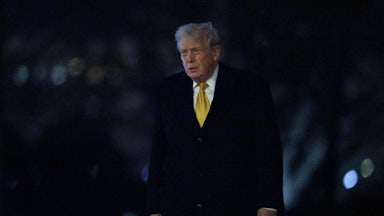Now that Donald Trump has held his long-advertised rally at Madison Square Garden, some are claiming that the event’s parade of ugly, racist displays represents a diversion of sorts from his climactic argument of Election 2024. Kamala Harris’s spokespeople, for instance, declared that his campaign intended this as his “closing argument,” but added: “Instead of that, the event was roundly slammed for being an offensive, dark, dangerous spectacle.”
Note the word “instead.” Similarly, here’s how The New York Times described the vile scene:
By the time the former president himself took the stage, an event billed as delivering the closing message of his campaign, with nine days left in a tossup race, had instead become a carnival of grievances, misogyny, and racism.
This, and other news stories using similar language, imply that in some sense, the event at the Garden devolved in character into something other than what it was originally meant to be. The gathering went off the rails, goes this account, rather than offering a comprehensive statement of his true rationale for seeking the highest office in the land.
But why should we understand it that way? The event at the Garden actually is Trump’s closing argument.
This isn’t to say that the “grievances, misogyny, and racism” on display are the only things he’s closing on at the end of this presidential race. There is certainly a lot of messaging about the economy as well. Rather, it’s to say that this spectacle absolutely should be seen as an explicit, very public declaration that when he wins, well, he told you exactly what you were going to get, so you’d better bend the knee and get ready to swallow all of it.
For many months, Trump and his top allies have been engaged in a two-step. Trump has been running on an explicit platform of ramped-up racism, vows of a mass purging of the nation’s internal enemies, and open threats of cleansing retribution and authoritarian violence. Again and again, as Trump has laid all this bare, his spinners and advisers have insisted that he doesn’t really mean what he’s saying, he’s being taken out of context, he’s not actually threatening to do what he’s telling us he’ll do in his own words.
The rally at Madison Square Garden is best understood as the final coming-out party, the ultimate declaration that, yes, he has indeed meant every word of it all along.
On Sunday, for instance, running mate JD Vance went on CNN and tried to whitewash Trump’s menacing intentions toward those he keeps labeling the domestic “enemy within.” Vance insisted, hilariously, that Trump has described leading Democrats not as the “enemy” but only as “threats to this country,” seemingly implying that Trump was merely making a point about policy. That’s nonsense: Trump has repeatedly and explicitly described Democrats and the media as the “enemy from within” and the “enemy of the people” and has regularly threatened to unleash state power on this enemy without cause.
But all that aside, what’s notable is that Trump used the rally at the Garden to reiterate his attacks on this “enemy.”
“When I say ‘the enemy from within,’ the other side goes crazy,” Trump told the rapturous crowd, speaking clearly about the people who run the Democratic Party. “They have done very bad things; they are indeed the enemy from within.” Trump also pointed directly at members of the media and declared: “They’re really the enemy, the enemy of the people.”
The racism was equally explicit. Comedian Tony Hinchcliffe called Puerto Rico a “floating island of garbage in the middle of the ocean.” Hinchcliffe also claimed that Latinos “love making babies,” and that “there’s no pulling out,” because they “come inside, just like they did to our country.” One speaker seethed that Harris has “pimp handlers.” And MAGA personality Tucker Carlson called her “a Samoan, Malaysian, low-IQ” candidate.
Even the deeper white nationalist ideological undercurrents were made explicit. “America is for Americans and Americans only,” longtime Trump adviser Stephen Miller declared triumphantly. Miller reacts angrily to those who compare this to 1930s Nazi ultranationalist rhetoric. But even if that precise parallel is unfair, Miller absolutely is echoing the reactionary rhetoric of the 1920s and 1930s in America.
Miller is trafficking in something like a contemporary version of the “100 percent Americanism” of that era. It drew on nativist and exclusionary sentiment to champion purification of the nation and the expulsion of the supposed polluting elements of the day: immigrants from Southern and Eastern Europe, who were often depicted as allied with subversive enemy forces within.
“Miller is evoking the extremist fascist rhetoric of prewar America,” Lauren Young, a scholar of fascism and right-wing movements at Yale, told me.
Many people have superficially compared this rally to the German American Nazi Bund rally at the Garden in 1939. But Young points to a deeper parallel: Both these rallies “mainstreamed extremist ideologies” at key moments, she said. Whereas the 1939 version deliberately sought to promote and normalize Nazi ideologies as the American public grappled with the rise of European fascism, Young noted, Trump’s rally at the Garden “showcased a radical, white nationalist, and misogynist platform explicitly promising violent purges of the Other” to the whole country before a national election.
“These are the closing arguments of the Trump campaign,” Young said.
Not long ago, Miller enthused rhapsodically that when Trump becomes president and carries out mass removals of millions, using giant camps and potentially the military, it will be “spectacular.” What Miller really meant is that voters should relish the spectacle of massive bloodletting to come—that they should anticipate this and get excited about it.
The explicit nature of all this is the point. Many have lamented the decision by The Washington Post (where I used to work) not to endorse any candidate, seeing it as a preemptive surrender to an authoritarian second term of Trump. But this decision—along with other acts of institutional cowardice—seems even worse in light of the Garden rally. The spectacle now looks almost like a celebratory flaunting of power and dominance. Even as our institutions are folding, Trump is loudly telling the country, here’s what they will not stand in the way of; here’s what’s coming.
A recent poll found that almost half of Americans think Trump is a fascist; among that group, 8 percent will vote for him. Whether or not you believe Trump would govern as a fascist dictator—I think a lower grade of authoritarianism is more likely—Trump is betting that the subset of voters who actively want authoritarian rule is larger than we think. And he’s daring us to prove him wrong.
Perhaps we should take him up on that before it’s too late.
